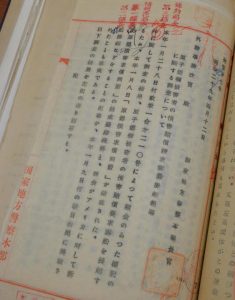Striving to fill voids in Hiroshima, unfinished judgment, Part 5: Foreign Ministry acted behind the scenes
Apr. 26, 2024
Request for “thought investigation” made to police
by Kyosuke Mizukawa, Senior Staff Writer
When this writer opened a thick file titled “Miscellaneous matters related to World War II” in the Diplomatic Archives at Japan’s Ministry of Foreign Affairs in Tokyo’s Minato Ward, where the ministry’s classified historical documents are archived, I found a page with the Hiroshima City Atomic Bomb Survivors Association bylaws written on it. The term “National Regional Police Headquarters” (present-day National Police Agency), written in red, also appeared on the same page.
The materials had been collected by the police during their investigation into the ideologies of the attorney Shoichi Okamoto and the survivors association, which together were preparing a lawsuit against the United States for damages caused by the atomic bombings. The background behind the so-called “thought investigation” was revealed to me as I turned the pages.
It all started with an editorial that appeared in the American newspaper the San Francisco Chronicle on January 14, 1954, which called out Mr. Okamoto’s movement for being dangerous and alarming as a weapon of communist propaganda. The article was published shortly after an alliance had been formed in Japan to file a lawsuit seeking compensation for the damages caused by the atomic bombings.
At that time, the winds of anti-communism in the form of the “Red Scare” were sweeping through the United States. Turning a blind eye to the still-suffering A-bomb survivors, the editorial claimed that the lawsuit could earn America’s enmity and urged Japanese government officials to investigate the true motives behind the campaign.
Foreign Ministry sensitive about relations with U.S.
Ryuji Takeuchi, then Japan’s charge d’affaires ad interim to the United States, reacted immediately to the editorial. He sent a letter to then-Foreign Minister Katsuo Okazaki, along with a newspaper clipping of the editorial in question, calling for the investigation noted in the article. Depicting the lawsuit campaign as having “great influence,” the letter reveals the nervousness at that time of the Foreign Ministry, which feared possible deterioration of relations with the United States.
The Foreign Ministry requested Japan’s Ministry of Justice and police authorities to investigate the history and background behind the movement. Both organizations collected meticulous details, including news articles covering the regulations of the alliance and Mr. Okamoto’s remarks, and also investigated whether there were any communists in the group. They reported their findings by April of that year, in the following way.
“Left-wing groups are fond of using the phrase ‘Ban the use of A-bombs,’ but we found no evidence that the alliance was connected to such groups, either personally or ideologically.” The results of the report were shared with Mr. Okazaki and Sadao Iguchi, who was Japan’s ambassador to the United States at the time.
The report also mentioned that Mr. Okamoto and his group were committed to “establishment of world justice” and “fundamental human rights for victims of the atomic bombings” through the banning of A-bombs. From Mr. Okamoto’s perspective, those issues should most certainly have been addressed by the government in a coherent manner.
Only one protest
“Use of the bomb in question is a crime against human culture” was the wording used in a letter of protest that the Japanese government had sent to the United States four days after the atomic bombing of Hiroshima, proclaiming it to have been an illegal act. However, that was the only protest Japan made, because cooperation with the United States had become a high priority after the Allied occupation of that country.
Nevertheless, Mr. Okamoto worked to contact Americans who were concerned about the protection of human rights in an attempt to build cooperative relationships. Among those he contacted was a major figure who had visited the A-bombed city.
(Originally published on April 26, 2024)








